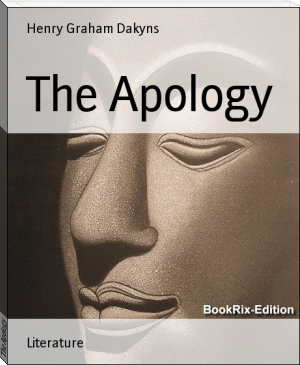On Horsemanship, Henry Graham Dakyns [free e books to read online TXT] 📗

- Author: Henry Graham Dakyns
Book online «On Horsemanship, Henry Graham Dakyns [free e books to read online TXT] 📗». Author Henry Graham Dakyns
I
Claiming to have attained some proficiency in horsemanship (1) ourselves, as the result of long experience in the field, our wish is to explain, for the benefit of our younger friends, what we conceive to be the most correct method of dealing with horses.
(1) Lit. "Since, through the accident of having for a long time
'ridden' ourselves, we believe we have become proficients in
horsemanship, we wish to show to our younger friends how, as we
conceive the matter, they will proceed most correctly in dealing
with horses." {ippeuein} in the case of Xenophon = serve as a
{ippeus}, whether technically as an Athenian "knight" or more
particularly in reference to his organisation of a troop of
cavalry during "the retreat" ("Anab." III. iii. 8-20), and, as is
commonly believed, while serving under Agesilaus ("Hell." III. iv.
14) in Asia, 396, 395 B.C.
There is, it is true, a treatise on horsemanship written by Simon, the same who dedicated the bronze horse near the Eleusinion in Athens (2) with a representation of his exploits engraved in relief on the pedestal. (3) But we shall not on that account expunge from our treatise any conclusions in which we happen to agree with that author; on the contrary we shall hand them on with still greater pleasure to our friends, in the belief that we shall only gain in authority from the fact that so great an expert in horsemanship held similar views to our own; whilst with regard to matters omitted in his treatise, we shall endeavour to supply them.
(2) L. Dind. (in Athens). The Eleusinion. For the position of this
sanctuary of Demeter and Kore see Leake, "Top. of Athens," i. p.
296 foll. For Simon see Sauppe, vol. v. Praef. to "de R. E." p.
230; L. Dind. Praef. "Xen. Opusc." p. xx.; Dr. Morris H. Morgan,
"The Art of Horsemanship by Xenophon," p. 119 foll. A fragment of
the work referred to, {peri eidous kai ekloges ippon}, exists. The
MS. is in the library of Emmanual Coll. Cant. It so happens that
one of the hipparchs (?) appealed to by Demosthenes in Arist.
"Knights," 242.
{andres ippes, paragenesthe nun o kairos, o Simon, o Panaiti, ouk elate pros to dexion keras};
bears the name.
(3) Lit. "and carved on the pedestal a representation of his own
performances."
As our first topic we shall deal with the question, how a man may best avoid being cheated in the purchase of a horse.
Take the case of a foal as yet unbroken: it is plain that our scrutiny must begin with the body; an animal that has never yet been mounted can but present the vaguest indications of spirit. Confining ourselves therefore to the body, the first point to examine, we maintain, will be the feet. Just as a house would be of little use, however beautiful its upper stories, if the underlying foundations were not what they ought to be, so there is little use to be extracted from a horse, and in particular a war-horse, (4) if unsound in his feet, however excellent his other points; since he could not turn a single one of them to good account. (5)
(4) Or, "and that a charger, we will suppose." For the simile see
"Mem." III. i. 7.
(5) Cf. Hor. "Sat." I. ii. 86:
regibus hic mos est: ubi equos mercantur, opertos inspiciunt, ne, si facies, ut saepe, decora molli fulta pede est, emptorem inducat hiantem, quod pulchrae clunes, breve quod caput, ardua cervix.
and see Virg. "Georg." iii. 72 foll.
In testing the feet the first thing to examine will be the horny portion of the hoof. For soundness of foot a thick horn is far better than a thin. Again it is important to notice whether the hoofs are high both before and behind, or flat to the ground; for a high hoof keeps the "frog," (6) as it is called, well off the ground; whereas a low hoof treads equally with the stoutest and softest part of the foot alike, the gait resembling that of a bandy-legged man. (7) "You may tell a good foot clearly by the ring," says Simon happily; (8) for the hollow hoof rings like a cymbal against the solid earth. (9)
(6) Lit. "the swallow."
(7) Al. "a knock-kneed person." See Stonehenge, "The Horse" (ed.
1892), pp. 3, 9.
(8) Or, "and he is right."
(9) Cf. Virg. "Georg." iii. 88; Hor. "Epod." xvi. 12.
And now that we have begun with the feet, let us ascend from this point to the rest of the body. The bones (10) above the hoof and below the fetlock must not be too straight, like those of a goat; through not being properly elastic, (11) legs of this type will jar the rider, and are more liable to become inflamed. On the other hand, these bones must not be too low, or else the fetlock will be abraded or lacerated when the horse is galloped over clods and stones.
(10) i.e. "the pasterns ({mesokunia}) and the coffin should be
'sloping.'"
(11) Or, "being too inflexible." Lit. "giving blow for blow, overuch
like anvil to hammer."
The bones of the shanks (12) ought to be thick, being as they are the columns on which the body rests; thick in themselves, that is, not puffed out with veins or flesh; or else in riding over hard ground they will inevitably be surcharged with blood, and varicose conditions be set up, (13) the legs becoming thick and puffy, whilst the skin recedes; and with this loosening of the skin the back sinew (14) is very apt to start and render the horse lame.
(12) i.e. "the metacarpals and metatarsals."
(13) Or, "and become varicose, with the result that the shanks swell
whilst the skin recedes from the bone."
(14) Or, "suspensory ligament"? Possibly Xenophon's anatomy is wrong,
and he mistook the back sinew for a bone like the fibula. The part
in question might intelligibly enough, if not technically, be
termed {perone}, being of the brooch-pin order.
If the young horse in walking bends his knees flexibly, you may safely conjecture that when he comes to be ridden he will have flexible legs, since the quality of suppleness invariably increases with age. (15) Supple knees are highly esteemed and with good reason, rendering as they do the horse less liable to stumble or break down from fatigue than those of stiffer build.
(15) Lit. "all horses bend their legs more flexibly as time advances."
Coming to the thighs below the shoulder-blades, (16) or arms, these if thick and muscular present a stronger and handsomer appearance, just as in the case of a human being. Again, a comparatively broad chest is better alike for strength and beauty, and better adapted to carry the legs well asunder, so that they will not overlap and interfere with one another. Again, the neck should not be set on dropping forward from the chest, like a boar's, but, like that of a game-cock rather, it should shoot upwards to the crest, and be slack (17) along the curvature; whilst the head should be bony and the jawbone small. In this way the neck will be well in front of the rider, and the eye will command what lies before the horse's feet. A horse, moreover, of this build, however spirited, will be least capable of overmastering the rider, (18) since it is not by arching but by stretching out his neck and head that a horse endeavours to assert his power. (19)
(16) Lit. "the thighs below the shoulder-blades" are distinguished
from "the thighs below the tail." They correspond respectively to
our "arms" (i.e. forearms) and "gaskins," and anatomically
speaking = the radius (os brachii) and the tibia.
(17) "Slack towards the flexure" (Stonehenge).
(18) Or, "of forcing the rider's hand and bolting."
(19) Or, "to display violence or run away."
It is important also to observe whether the jaws are soft or hard on one or other side, since as a rule a horse with unequal jaws (20) is liable to become hard-mouthed on one side.
(20) Or, "whose bars are not equally sensitive."
Again, a prominent rather than a sunken eye is suggestive of alertness, and a horse of this type will have a wider range of vision.
And so of the nostrils: a wide-dilated nostril is at once better than a contracted one for respiration, and gives the animal a fiercer aspect. Note how, for instance, when one stallion is enraged against another, or when his spirit chafes in being ridden, (21) the nostrils at once become dilated.
(21) Or, "in the racecourse or on the exercising-ground how readily he
distends his nostrils."
A comparatively large crest and small ears give a more typical and horse-like appearance to the head, whilst lofty withers again allow the rider a surer seat and a stronger adhesion between the shoulders and the body. (22)
(22) Or if with L. D. ({kai to somati}), transl. "adhesion to the
horse's shoulders."
A "double spine," (23) again, is at once softer to sit on than a single, and more pleasing to the eye. So, too, a fairly deep side somewhat rounded towards the belly (24) will render the animal at once easier to sit and stronger, and as a general rule better able to digest his food. (25)
(23) Reading after Courier {rakhis ge men}. See Virg. "Georg." iii.
87, "at duplex agitur per lumbos spina." "In a horse that is in
good case, the back is broad, and the spine does not stick up like
a ridge, but forms a kind of furrow on the back" (John Martyn); "a
full back," as we say.
(24) Or, "in proportion to." See Courier ("Du Commandement de la
Cavalerie at de l'Equitation": deux livres de Xenophon, traduits
par un officier d'artillerie a cheval), note ad loc. p. 83.
(25) i.e. "and keep in good condition."
The broader and shorter the loins the more easily will the horse raise his forequarters and bring up his hindquarters under him. Given these points, moreover, the belly will appear as small as possible, a portion of the body which if large is partly a disfigurement and partly tends to make the horse less strong and capable of carrying weight. (26)
(26) Al. "more feeble at once and ponderous in his gait."
The quarters should be broad and fleshy in correspondence with the sides and chest, and if they are also firm and





Comments (0)